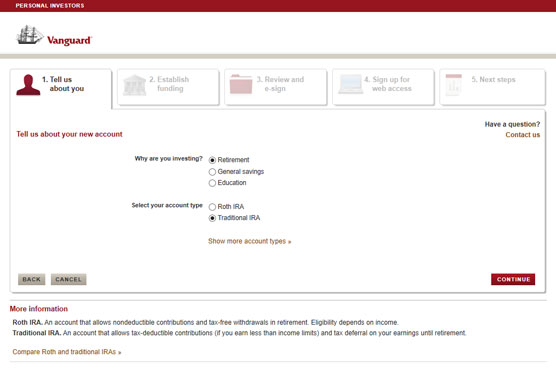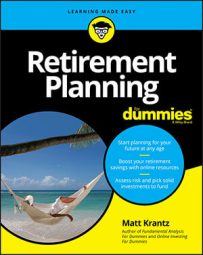It might seem tempting to skip the process of registering for online access of your IRA account. If you do that, though, you’ll seriously miss out. Yes, you could manage your IRA over the phone and through the mail. But even if you’re a hands-off investor, you’re much better off doing everything online.
Be sure you know how to get online access to your 401(k)as well.
How to open your IRA account
Opening an IRA varies based on the provider, but you can expect a basic script similar to the following, which is the way Vanguard does it:- Go to the IRA provider's website and find the button for opening an account. IRA providers make this button easy to find. On most sites, it's in the upper-right corner of the screen.
- Choose a new account or a rollover. Remember, you can always open a brand new IRA account if you’re just getting started. But if you’ve been saving for retirement somewhere else, you can rollover, or transfer, money from a 401(k), another IRA, or sometimes even a pension.
- Show me the money. The first thing the IRA provider will want to know is how you’ll fund the account. You can electronically move money from a checking or savings account. You can also rollover from another plan or transfer securities you own elsewhere. If you're funding your account through your bank, you need your bank account information.
- Do one of the following:
- If you already have another account with the IRA provider: You might have an older account with the IRA provider. If you do, sign in. By opening the new IRA with your existing login information, you'll avoid typing lots of information all over again. It’s also easier to manage your accounts if they’re associated with the same username.
- If you’re opening a first account with the IRA provider: Be prepared to answer a bunch of questions. You’ll need to enter information about yourself, including a Social Security number and address.
- Choose the type of account: You need to know the type of account you want to open. You'll be asked if the account is for retirement, general savings, or education (as shown in Figure 8-1). If you choose a retirement account, you’ll be asked if you want a traditional IRA, Roth IRA, SIMPLE IRA, or SEP IRA.
- Answer questions, set up funding, and e-sign. You’ll be asked to enter the amount of your initial investment. If you’re opening an account with this IRA provider for the first time, you’ll also need to enter a username and password for online access.
- Wait. Some IRA providers will open your account immediately if everything you entered checks out. Others, such as Vanguard, confirm your information, which can take a day or two.
 Vanguard’s online IRA application steps you through opening an account and getting online access.
Vanguard’s online IRA application steps you through opening an account and getting online access.Log in and look around
The long road to setting up your IRA is over and you're now an IRA owner. How cool is that? Next, it’s time to see what you can find on the IRA provider’s site. The list is long:- Account information: All IRA sites can tell you how much is in your account (your balance) and your investments, or
- Account activity: Any time you put money into (contribute to), your IRA or take money out of (withdraw from), your IRA, the transaction is recorded. Your account activity shows the comings and goings of the money in your account.
Money can come into or go out of your account, even if you’re not putting it in or taking it out. Is your long-lost rich uncle putting money into your IRA? Nope. If you own stock in a company that makes a profit beyond what it needs, the company might pay you, the investor. These payments are called dividends and appear in your account activity. What about money coming out? Fees. The IRA provider might take money out of your account for account-servicing costs.
If you own mutual funds, the (sometimes large) fees they charge won’t appear in the account activity listing. Mutual fund fees are taken out of the fund itself.
- Performance: Remember getting a report card when you were a kid? Your IRA's report card is its performance tracking. Here you see how much your IRA is growing or shrinking during the year and over the long term.
- Asset mix: Your asset mix, or asset allocation, is the combination of asset classes in your portfolio, such as stocks and bonds. The more stocks in your portfolio, the riskier your portfolio but the more it's likely to grow in the long term.
Understand your portfolio holdings
If you want to dig deeper into what you own in your IRA, look for an area called Holdings. In this section, you’ll find the following important attributes of the investments in your account:- Summary: Here you’ll find the name of each investment you own and its symbol. Mutual funds and other investment funds are identified by a multi-character abbreviation, or symbol. This symbol is useful if you want to look the fund up using a third-party site.
- Returns: The amount of money you make or lose from an investment is more than how much its price has changed. It’s also a tally of the dividends paid. The Returns section adds all this together. You can find your return on an investment during several time periods, such as one, three, five, and ten years.
- Cost basis: Your cost basis of an investment is how much you paid to buy it. If you paid $100 for a share of a mutual fund that’s now worth $110 a share, your cost basis is $100. If you sell the mutual fund for $110 a share, you have a realized capital gain, or profit, of $10. If you don’t sell the mutual fund but hold it, you have an unrealized capital gain of $10. Your IRA provider tracks capital gains for you.
Tracking your capital gains is a big deal with taxable accounts but not with tax-deferred ones such as traditional IRAs. With a taxable account, you pay taxes on only your realized gains. But with an IRA, your entire withdrawal is taxable—even your cost basis because it hasn’t been taxed yet.

